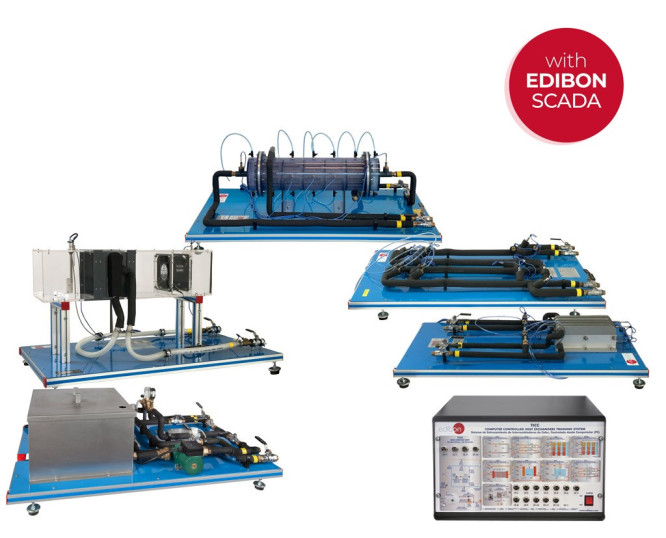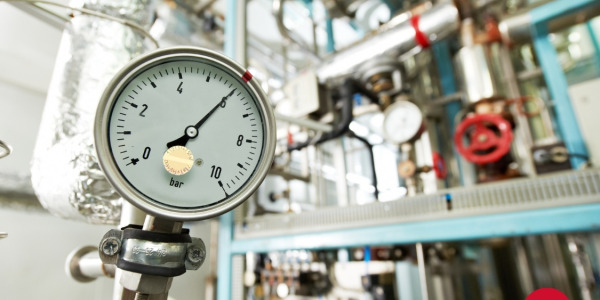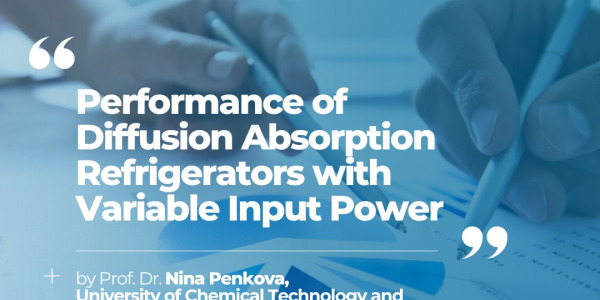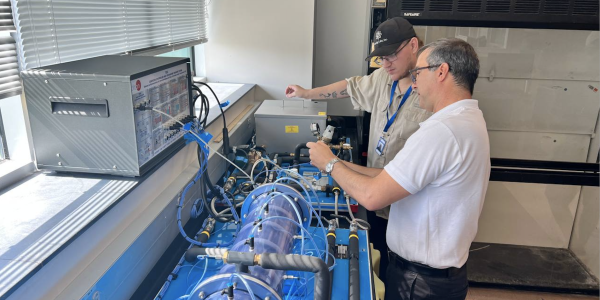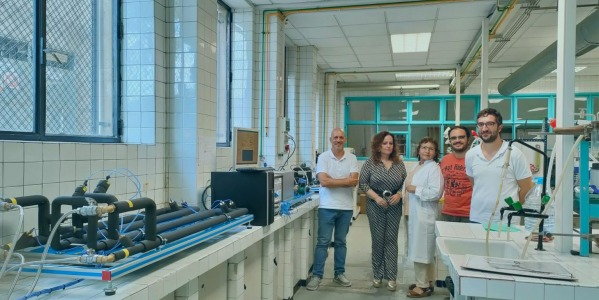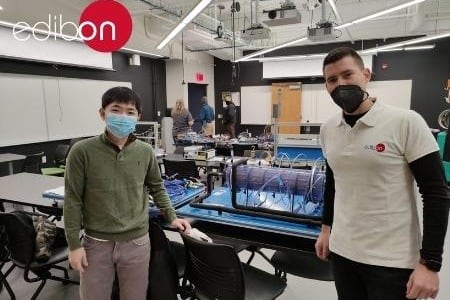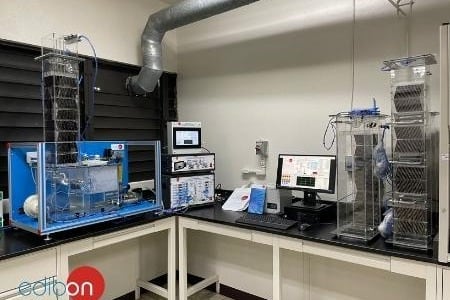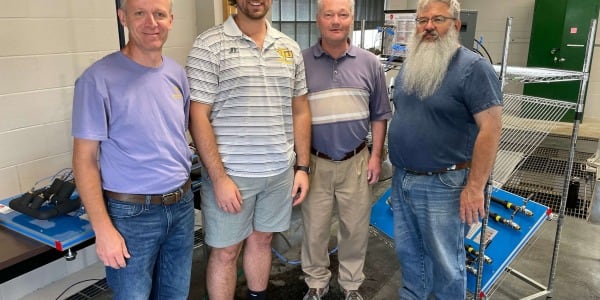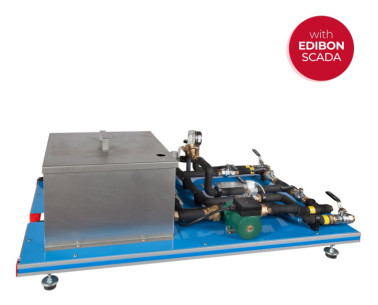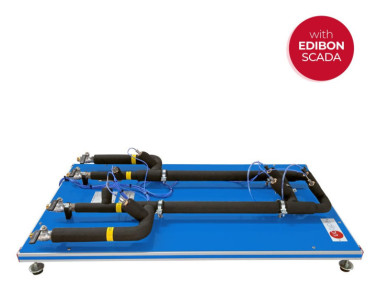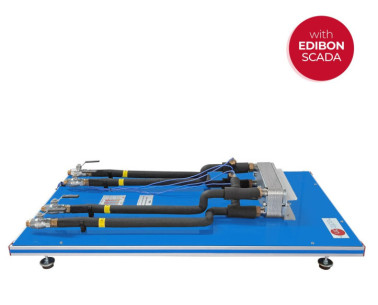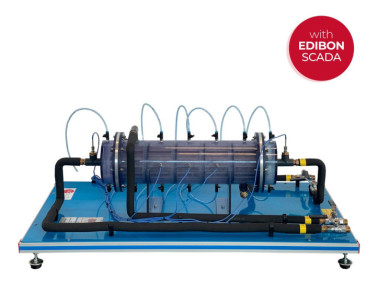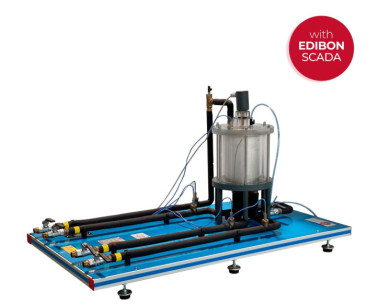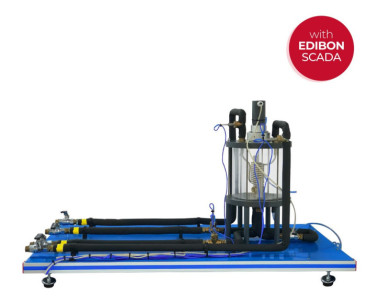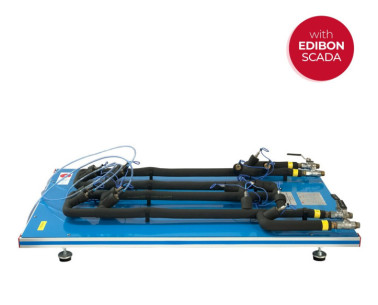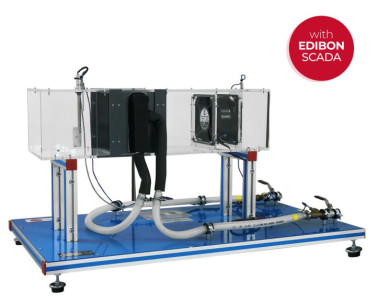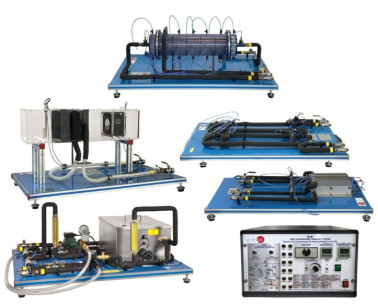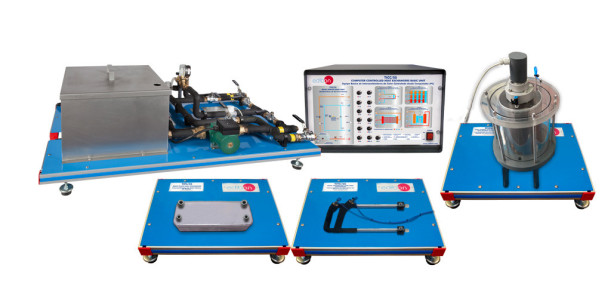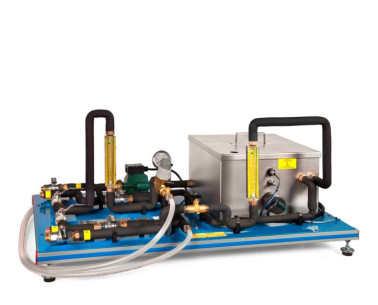TICC 컴퓨터(PC)로 제어되는 열교환기 훈련 시스템
혁신적인 시스템
The Computer Controlled Heat Exchangers Training System, "TICC", has been designed by EDIBON to study and compare different types of small-scale heat exchangers working with parallel or counterflow arrangements.
실험실
관련 뉴스
일반적인 설명
The Computer Controlled Heat Exchangers Training System, "TICC", has been designed by EDIBON to study and compare different types of small-scale heat exchangers working with parallel or counterflow arrangements.
The minimum supply consists of two main elements: the Base Service Unit, "TIUS", and at least one of the required elements described below.
The Base Service Unit, "TIUS", has the following functions:
- Heating water in a computer controlled thermostatic bath.
- Pumping the hot water.
- Regulation and measurement of the cold water and hot water flows.
- Measurement of the inlet and outlet temperatures of the cold water and the hot water.
- Measurement of the pressure drop in the exchanger.
Required elements (at least one) (Not included):
- TITC. Concentric Tube Heat Exchanger for TICC: It has been designed by EDIBON to study the heat transfer between hot water flowing through an internal tube and cold water flowing through the annular area between the internal and the external tubes.
- TITCA. Extended Concentric Tube Heat Exchanger for TICC: It has been designed by EDIBON to study the heat transfer between hot water flowing through an internal tube and cold water flowing through the annular area between the internal and the external tubes.
- TIPL. Plate Heat Exchanger for TICC: It has been designed by EDIBON to study the heat transfer between hot water and cold water flowing through alternate channels formed between parallel plates.
- TIPLA. Extended Plate Heat Exchanger for TICC: It has been designed by EDIBON to study the heat transfer between hot water and cold water flowing through alternate channels formed between parallel plates.
- TICT. Shell and Tube Heat Exchanger for TICC, designed by EDIBON, consists of a series of tubes inside the heat exchanger where hot water flows. The cooling water flows through the space between the inner tubes and the shell.
- TIVE. Jacketed Vessel Heat Exchanger for TICC, designed by EDIBON, allows the study of heat transfer between hot water flowing through a jacket and the cold water contained in a vessel.
- TIVS. Coil Vessel Heat Exchanger for TICC, designed by EDIBON, allows the study of heat transfer between hot water flowing through a coil and cold watercontained in the vessel.
- TIFT. Turbulent Flow Heat Exchanger for TICC designed by EDIBON, Let us study the heat transfer between hot water that circulates through an internal tubeand cold water that flows through the annular zone between the internal and the external tube.
- TICF. Cross Flow Heat Exchanger for TICC, designed by EDIBON, to study heat transfer between two fluids in cross flow configuration. Hot water flow coming from the base unit enters and leaves a radiator perpendicular to an air current, which is generated by a fan.
This Computer Controlled Unit is supplied with the EDIBON Computer Control System (SCADA), and includes: The unit itself + aControl Interface Box + a Data Acquisition Board + Computer Control, Data Acquisition and Data Management Software Packages, for controlling the process and all parameters involved in the process.
액세서리
TICC용 동축 튜브 열교환기
TICC용 확장 동축 튜브 열교환기
TICC용 플레이트 열교환기
TICC용 확장 플레이트 열교환기
TICC용 셸 및 튜브 열교환기
TICC용 재킷 용기 열교환기
TICC용 코일이 있는 재킷 용기 열교환기
TICC용 난류 열교환기
TICC용 교차 흐름 열교환기
연습 및 가이드
매뉴얼에 포함 된 가이드 실기 연습
Practices to be done with the Concentric Tube Heat Exchanger for TICC (TITC):
- Global energy balance in the heat exchanger and the study of losses.
- Exchanger effectiveness determination. NTU Method.
- Study of the heat transfer under counter-current and co-current flow conditions.
- Flow influence on the heat transfer. Reynolds number calculation.
Additional practical possibilities:
- Sensors calibration.
- Study of the hysteresis of the flow sensor.
Practices to be done with the Extended Concentric Tube Heat Exchanger for TICC (TITCA):
- Global energy balance in the heat exchanger and the study of losses.
- Exchanger effectiveness determination. NTU Method.
- Study of the heat transfer under counter-current and co-current flow conditions.
- Flow influence on the heat transfer. Reynolds number calculation.
Additional practical possibilities:
- Sensors calibration.
- Study of the hysteresis of the flow sensor.
Practices to be done with the Plate Heat Exchanger for TICC (TIPL):
- Study of the hysteresis of the flow sensor.
- Global energy balance in the heat exchanger and the study of losses.
- Exchanger effectiveness determination. NTU Method.
- Study of the heat transfer under counter-current and co-current flow conditions.
- Influence of the flow in heat transfer. Calculation of Reynolds number.
Additional practical possibilities:
- Sensors calibration.
- Study of the hysteresis of the flow sensor.
Practices to be done with the Extended Plate Heat Exchanger for TICC (TIPLA):
- Global energy balance in the heat exchanger and the study of losses.
- Exchanger effectiveness determination. NTU Method.
- Study of the heat transfer under counter-current and co-current flow conditions.
- Flow influence on the heat transfer. Reynolds number calculation.
Additional practical possibilities:
- Sensors calibration.
- Study of the hysteresis of the flow sensor.
Practices to be done with the Shell and Tube Heat Exchanger for TICC (TICT):
- Global energy balance in the heat exchanger and the study of losses.
- Obtainment and representation of the temperature distribution in a shell and tube exchanger.
- Calculation of the LMTD for a shell and tube exchanger.
- Calculation of the overall heat transfer coefficient in a shell and tube exchanger.
- Exchanger effectiveness determination. NTU Method.
- Influence of the flow in the heat transfer. Calculation of Reynolds number in the side of the tubes.
- Influence of the flow in the heat transfer. Calculation of Reynolds number in the side of the shell.
- Obtainment of Prandtl number for the tubes side.
- Obtainment of Prandtl number for the shell side.
- Obtainment of Nusselt number and the heat transfer coefficient by convection (hi) for the side of the tubes.
- Obtainment of Nusselt number and the heat transfer coefficient by convection (ho) for the side of the shell.
Additional practical possibilities:
- Sensors calibration.
- Study of the heat transfer under counter-current and co-current flow conditions.
- Flow influence on the heat transfer. Reynolds number calculation.
- Study of the hysteresis of the flow sensor.
Practices to be done with the Jacketed Vessel Heat Exchanger for TICC (TIVE):
- Global balance of energy in the heat exchanger and losses study.
- Determination of the exchanger effectiveness. NTU Method.
- Influence of the flow on the heat transfer. Calculation of the number of Reynolds.
- Influence of the vessel’s water volume on the heat transfer when operating in batches.
Additional exercises and practical possibilities
- Sensors calibration.
- Influence of the vessel stirring on the heat transfer when operating in batches.
- Study of the hysteresis of the flow sensor.
Practices to be done with the Coil Vessel Heat Exchanger for TICC (TIVS):
- Global balance of energy in the heat exchanger and the study of losses.
- Determination of the exchanger effectiveness. NTU Method.
- Influence of the flow on the heating transfer. Calculation of Reynolds number.
- Influence of the water volume in the vessel on the heat transfer with operation in batches.
Additional exercises and practical possibilities
- Sensors calibration.
- Study of the hysteresis of the flow sensor.
- Influence of the stirring vessel on the heat transfer with operation in batches.
Practices to be done with the Turbulent Flow Heat Exchanger for TICC (TIFT):
- Global energy balance in the heat exchanger and loss study.
- Determination of the exchanger effectiveness. NTU Method.
- Study of the heat transfer in counter-current and co-current flow conditions.
- Flow influence on heat transfer. Reynolds number calculation.
- Obtaining of the correlation that relates Nusselt number with Reynolds number and Prandtl number.
- Obtaining of the heat transfer coefficients by convection.
Additional practical possibilities:
- Sensors calibration.
- Study of the hysteresis in the flow sensors.
Practices to be done with the Cross Flow Heat Exchanger for TICC (TICF):
- Overall energy balance in the heat exchanger and study of losses.
- Determination of the exchanger effectiveness (NTU method).
- Influence of air and water flow on the heat transfer. Reynolds number calculation.
Additional practical possibilities:
- Sensors calibration.
- Introduction to the concept of psychometric properties.
- Effect of temperature differential on the heat transfer coefficient.
- Familiarization with cross flow heat exchanger.
- Study of the hysteresis in the flow sensors.
장비로 수행 할 수있는 더 많은 실용적 연습
- Many students view results simultaneously. To view all results in real time in the classroom by means of a projector or an electronic whiteboard.
- Open Control, Multicontrol and Real Time Control. This unit allows intrinsically and/or extrinsically to change the span, gains, proportional, integral, derivative parameters, etc, in real time.
- The Computer Control System with SCADA and PID Control allow a real industrial simulation.
- This unit is totally safe as uses mechanical, electrical/electronic, and software safety devices.
- This unit can be used for doing applied research.
- This unit can be used for giving training courses to Industries even to other Technical Education Institutions.
- Control of the unit process through the control interface box without the computer.
- Visualization of all the sensors values used in the unit process.
- By using PLC-PI additional 19 more exercises can be done.
- Several other exercises can be done and designed by the user
비슷한 제품
열교환기 훈련 시스템
Computer Controlled Heat Exchangers Basic Unit
보완 장비
모든 "TI" 유형의 열교환기에 공통인 기본 서비스 및 베이스 모듈
TICC용 동축 튜브 열교환기
TICC용 확장 동축 튜브 열교환기
TICC용 플레이트 열교환기
TICC용 확장 플레이트 열교환기
TICC용 셸 및 튜브 열교환기
TICC용 재킷 용기 열교환기
TICC용 코일이 있는 재킷 용기 열교환기
TICC용 난류 열교환기
TICC용 교차 흐름 열교환기
열교환기 훈련 시스템
모든 "TI..B" 유형의 열교환기에 공통인 기본 서비스 및 베이스 모듈
품질

판매 후 서비스

 쿠키 기본 설정
쿠키 기본 설정

